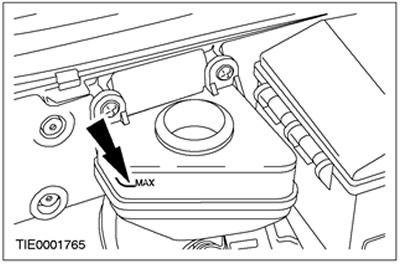WARNING: Brake fluid contains polyglycerol esters and polyglycerol. Avoid contact with eyes. Wash your hands thoroughly after handling brake fluid. If brake fluid gets into your eyes, rinse your eyes for 15 minutes with cold running water. If irritation persists, seek medical attention. If brake fluid is swallowed, drink water and induce vomiting. Seek immediate medical attention. Failure to follow these instructions may result in injury.
WARNING: Make sure the vehicle is on a level, level surface.
WARNING: If brake fluid comes into contact with the paintwork, the affected area must be washed immediately with cold water.
CAUTION: On vehicles equipped with anti-lock brakes, be sure to disconnect the ground wire from the battery.
NOTE: The system consists of separate circuits for each front and diagonally opposite rear wheel. Air removal can be carried out in each circuit separately.
NOTE: Hydraulic control box (HCU) ABS system is supplied filled with brake fluid. Therefore, the traditional bleeding procedure is sufficient to remove all air from the brake system.
1. Add brake fluid to the reservoir up to the MAX mark.

2.
CAUTION: The manufacturer's instructions must be followed strictly.
Perform a pressurized bleed from the brake system using suitable bleed equipment and following the equipment manufacturer's instructions.
3.
CAUTION: After bleeding the brake lines, make sure the cap is on the bleed valve. This will prevent corrosion of the bleed nipple. Failure to follow this instruction may cause the bleed nipple to stick.
If necessary, add brake fluid to the reservoir up to the MAX mark.

Visitor comments